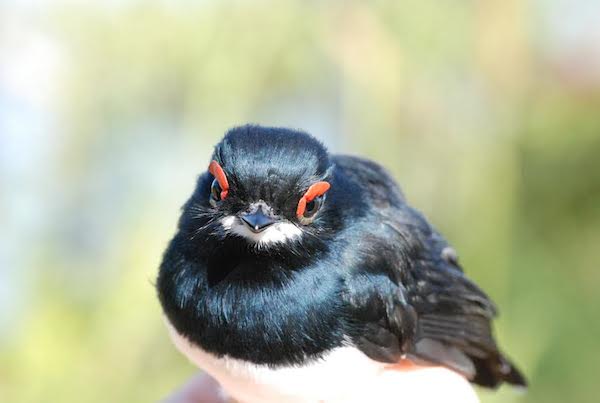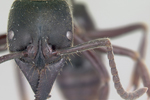New study finds habitat fragmentation may lead to increased nest predation
The tropical montane forests of the Cameroon mountain ranges boast fertile volcanic soils, high biodiversity of grasses and non-woody plants, as well as many endemic bird species that can be found only in this high-altitude region. Yet, many of these endemic bird species may be at risk due to increased nest predation linked with human-induced forest degradation, according to a new study published this week in mongabay.com’s open-access journal, Tropical Conservation Science.
The authors write that the scientific community has long presumed habitat fragmentation in tropical regions causes an increase in bird nest predation, yet this theory has rarely been tested in the field due to limited data on forest degradation in tropical areas. To fill in this information gap, Ondřej Sedláček of Charles University in Prague and his team of researchers worked extensively in the Afromontane forests of the Bamenda-Banso Highlands in northwestern Cameroon examining the impact of forest fragmentation on bird nesting success rates.

The endemic banded wattle-eye (Platysteira laticincta) of the Bamenda-Banso Highlands. The species is listed by the IUCN as Endangered. Photo by Ondřej Sedláček.
Their study supports the hypothesis that bird nest predation increases along the edges of small, degraded forest patches. They write that nest predation is a critical contributing factor to bird population decline and local extinction in the all-too-commonly fragmented habitats of tropical forests.
Sedláček and his team observed “edge effects” – effects at the transitions between landscape types – on bird nest predation activity in two study sites in the Bamenda-Banso Highlands. They compared nest success rates within a large forested area in the Kilum-Ijim forest to egg-nest survivability in small, fragmented forest patches in the Kefem forest.

A view of the large montane forest patch Kilum-Ijim forest around Lake Oku in the Bamenda-Banso Highlands. Photo by Ondřej Sedláček.
In November of 2008 and 2009, the researchers placed artificial nests within typical forest shrub understory during the breeding season of many local bird species. They formed the nests in a natural open-cup shape out of cotton material, with forest leaf litter attached to the outsides to make them look more authentic. In each they put an egg from a zebra finch (Taeniopygia guttata). Between 90 and 100 nests were placed within the interior of bird habitat and along the forest edges at both study sites.
The results of their experiment revealed equal overall nest predation in both the large forested area of the Kilum-Ijim forest and small fragmented patches of the Kefem forest. However, a closer look showed an uneven distribution of predation within the two landscapes. The small, fragmented areas in the Kefem forest experienced higher rates of predation along the forest edges than within its interior. Similar results also occurred at the Kilum-Ijim site, yet the effect was not as strong.

A real nest of white-bellied crested flycatcher (Elminia albiventris) in the Bamenda-Banso Highlands. Photo by Ondřej Sedláček.
These findings suggest that bird species living in small, fragmented forest patches are at a higher risk to nest predation. Since the majority of remaining montane forest in the region exists as small, fragmented patches, this may be affecting range-restricted bird species of the Bamenda-Banso Highlands, according to the authors.
From their observations, the researchers identified the most dominant nest predators as being small mammals such as mice, squirrels, and shrews. In the tropics, snakes are usually the most common bird nest predators, but because of the high altitude and cool climate, snakes are rare within the Bamenda-Banso Highlands. Additionally, other bird species are also known to raid the nests of other birds. The researchers observed speckled mousebird (Colius striatus) as well as western mountain greenbul (Andropadus tephrolaemus) predating on nests in the Highlands.

The Cameroon sunbird (Cyanomitra oritis) is endemic to the Cameroon mountains. Photo by Ondřej Sedláček.

Another endemic bird species of the Cameroon mountains, the yellow-breasted boubou (Laniarius atroflavus). Photo by Ondřej Sedláček.
Nevertheless, there are some limitations to the results of this study. The researchers write that their study results should be interpreted with caution when relating them to natural conditions as the nest predation patterns of their study may be different than what is observed in natural situations. For instance, artificial nests and zebra finch eggs may attract different predators than the nests and eggs of native species.
The study results may also have been influenced by differences in the landscape structure of the two forest sites. The Kilum-Ijim site has sharp forest edges and drastic transitions from forest to agriculture land, whereas semi-natural grassland and pastures surround the small forest patches of the Kefem site.
Montane cloud forests in Africa are critically threatened habitats due to dense human populations and favorable agricultural conditions, according to the researchers. The Kilum-Ijim forest located around Mt. Oku is the largest continuous remaining patch of Afromontane forest in western Africa, stretching across 20,000 hectares.

A heavily degraded forest from human activity within the Bamenda-Banso Highlands. Photo by Ondřej Sedláček.
According to Global Forest Watch, the northwestern region of Cameroon lost 9,503 hectares of forest cover from 2001 through 2012. More than 60 percent of the country is covered by dense forest, much of which has been disturbed. Cameroon’s forests contribute to its economy, with the forestry sector bringing in more than $695 million in 2011, amounting to about 2.8 percent of its GDP. In addition, Cameroon’s forests help stabilize climatic patterns within the Congo Basin and worldwide as well as store 2,696 million tons of carbon in living forest biomass.
From 1958 to 1988, the Bamenda-Banso Highlands lost 50 percent of its natural montane forest, according to the study. Despite forest regeneration efforts and designated protected areas, regions along the forest edges are used for intense cultivation, which puts additional stress on the overall ecosystem. Currently, the area supports a human population of about 370,000.
Bushfires are commonly used to remove elephant grass (Pennisetum purpureum) and other weeds from farmland, create grazing land, and to flush out small animals for hunting.

Northwestern Cameroon lost upwards of 10,000 hectares of forest from 2001 through 2013. However, most of its primary forest was lost before then as the region is mostly devoid of large tracts of intact forest. Fires are problematic in the region, with more than 200 detected by NASA satellite data in the past week alone (12/09 to 12/16). Map courtesy of Global Forest Watch. Click to enlarge.
“The unique landscape of montane forests in Bamenda Highlands is really seriously destroyed by man,” Sedláček told mongabay.com. “The situation is most pessimistic during the peak of the dry season, when bushfires dominate the landscape. This activity has the most destructive impact on remaining forest patches…established bushfires end up spreading over the whole mountain.”
As the forest landscape of the Bamenda-Banso Highlands continues to be converted for agriculture, the study’s authors recommend further research be done to more effectively monitor the impacts of human activity on both local birds and entire ecosystems.
Citations:
Hansen, M. C., P. V. Potapov, R. Moore, M. Hancher, S. A. Turubanova, A. Tyukavina, D. Thau, S. V. Stehman, S. J. Goetz, T. R. Loveland, A. Kommareddy, A. Egorov, L. Chini, C. O. Justice, and J. R. G. Townshend. 2013. “Hansen/UMD/Google/USGS/NASA Tree Cover Loss and Gain Area.” University of Maryland, Google, USGS, and NASA. Accessed through Global Forest Watch on Dec. 16, 2014. www.globalforestwatch.org.
“NASA Active Fires.” NASA FIRMS. Accessed through Global Forest Watch on Dec. 17, 2014. www.globalforestwatch.org.
Sedláček, O., Mikeš, M., Albrecht, T., Reif, J. and Hořák, D. 2014. Evidence for an edge effect on avian nest predation in fragmented afromontane forests in the Bamenda-Banso Highlands, NW Cameroon. Tropical Conservation Science Vol.7 (4): 720-732. Available online: www.tropicalconservationscience.orgRelated articles
Scientists use genes, feces to study disappearing monkeys

(09/24/2014) Human pressures through tree clearing and poaching are reducing both forest and fauna in West Africa. In response to dwindling primate populations, scientists used genetics techniques to examine their makeup and outlook – demonstrating the usefulness of such methods in the study of animals that are becoming ever-fewer in number and ever-harder to find.
Can it be stopped? Ghana’s forests ‘could completely disappear in less than 25 years’
(08/25/2014) Ghana contains forests that are biologically unique and important both for the wildlife they contain and the human communities that depend on them. However, the country is experiencing one of the greatest rates of deforestation in West Africa. At its current rate of forest loss, a study estimates that Ghana could be devoid of major forest cover in less than a quarter-century.
Don’t eat or touch bat bushmeat amid worsening Ebola outbreak, UN warns
(07/29/2014) The world’s worst Ebola outbreak was likely begun by a hunter shooting a fruit bat for their dinner or the market, according to the UN. The outbreak has killed over 660 people in six months to date, and recently spread via plane to Nigeria. The disease is particularly deadly with a mortality rate of around 90 percent.
Is Cameroon becoming the new Indonesia? Palm oil plantations accelerating deforestation

(06/25/2014) The potential for new laws governing the use of forest resources this year in Cameroon promises an opportunity to stem the rapid loss of forest in the biologically diverse country. But the changes may ultimately not be what’s needed to save Cameroon’s forests.
Greenpeace accuses controversial palm oil company and Cameroon government of illegal logging

(05/28/2014) Greenpeace has just accused one of the world’s most controversial oil palm companies, Herakles Farms, of colluding with top government officials to sell off illegally logged timber to China. According to a new report, an agreement between Cameroon’s Minister of Forestry and Herkales Farms—through a shell company—could torpedo the country’s agreement with the EU for better timber management.
Camera trap catches rare feline attempting to tackle armored prey (VIDEO)
(05/19/2014) One of the world’s least known wild cats may have taken on more than it could handle in a recent video released by the Gashaka Biodiversity Project from Nigeria’s biggest national park, Gashaka Gumti.
How locals and conservationists saved the elephants of Mali amidst conflict and poverty

(04/02/2014) At a time when Africa’s elephants are facing a relentless poaching crisis, one community has managed to safeguard their elephants in the most unlikely of places: Mali. In a country that has suffered from widespread poverty, environmental degradation, and, most recently, warfare, a collaboration between conservationists and the local community has kept Mali’s elephants from extinction.
Over 9,000 primates killed for single bushmeat market in West Africa every year

(03/24/2014) Over the past 25 years, West Africa’s primates have been put at risk due to an escalating bushmeat trade compounded with forest loss from expanding human populations. In fact, many endemic primates in the Upper Guinea forests of Liberia and Ivory Coast have been pushed to the verge of extinction. To better understand what’s happening, a recent study in mongabay.com’s open-access journal Tropical Conservation Science investigated the bushmeat exchange between these neighboring countries.
Frog creates chemical invisibility cloak to confuse aggressive ants

(03/14/2014) The African stink ant creates large underground colonies that are home to anywhere from hundreds to thousands of ants, and occasionally a frog or two. The West African rubber frog hides in the humid nests to survive the long dry season of southern and central Africa. However, the ant colonies are armed with highly aggressive ant militias that fight off intruders with powerful, venomous jaws. So how do these frogs escape attack?








